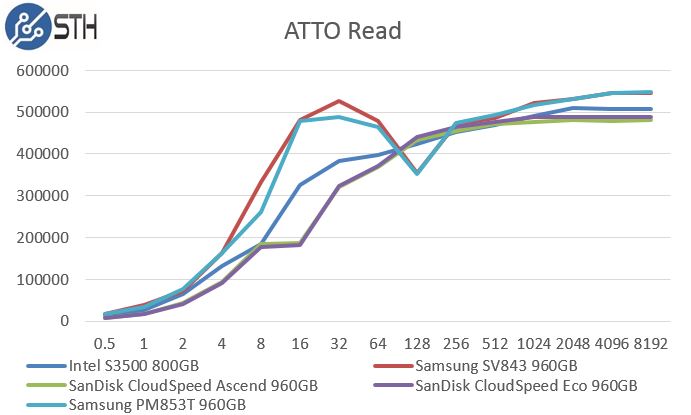One day after benchmarking the 480GB version, we now have results of the Samsung PM853T 960GB SSD. The Samsung PM853T 960GB has very similar specifications to its half-sized sibling. There is still Samsung TLC NAND rated at 0.3 DWPD over five years (assuming random 4K writes). The same tantalum capacitors provide power loss protection. We are mainly looking at a larger capacity drive so we have varied our comparison group to include other drives from additional brands versus the PM853T 480GB SSD benchmarks.
Test Configuration
Since we are going to assume the use of already released hardware, we are using a legacy system for testing across the test suite:
- Motherboard: Gigabyte GA-7PESH3
- Processors: Dual Intel Xeon E5-2690 (V2)
- SAS Controller: LSI SAS 3008
- RAM: 64GB DDR3L-1600MHz ECC RDIMMs
- OS SSD: Kingston V300 240GB
We are using a SAS controller so one cannot compare our SATA results directly to consumer-driven setups where a SATA SSD is connected to an Intel PCH port. There is a latency penalty for going over the PCIe bus to a controller to SAS. It also is a reason NVMe is going to be a game changer in the enterprise storage space. This impact is very tangible and we will have a piece comparing the SAS 3008 with a few other SATA controllers soon.
Samsung PM853T 960GB SSD Quick Benchmarks
For our quick tests during this part of the series we will just provide the quick benchmarks with only a bit of commentary. The results should be fairly straightforward and we have added a few results for comparison purposes.
AS SSD Benchmark
AS SSD is a solid benchmark that does not write compressible data to drives. The result is perhaps one of the best workstation SSD benchmarks available today.
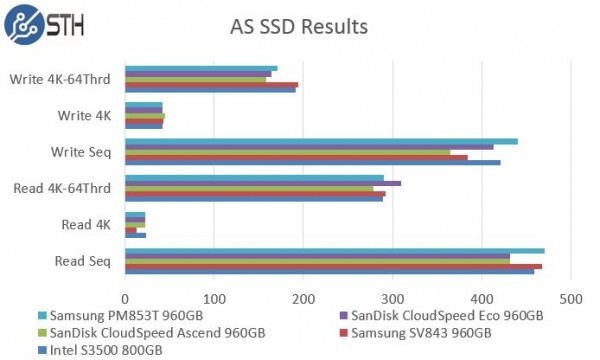
Included in this comparison group are two of SanDisk’s CloudSpeed line of 960GB SATA III SSDs along with the venerable Intel S3500 800GB as well as the Samsung SV843. Here we can see that the TLC based PM843T does perform well compared to the SanDisk CloudSpeed Eco (consumer NAND) and Ascend (eMLC) SSDs in terms of write tests. Likewise, other than the high queue depth reads, the Samsung PM853T 960GB SSD performs better than the Samsung competition. Both the SC843 and S3500 are able to post noticeably greater high queue depth writes than the PM853T.
CrystalDiskMark
CrystalDiskMark is another benchmark which gives non-compressible read/write numbers. This is in contrast to the ATTO Benchmark used by LSI/ Sandforce and its partners when they market a given solid state drive.
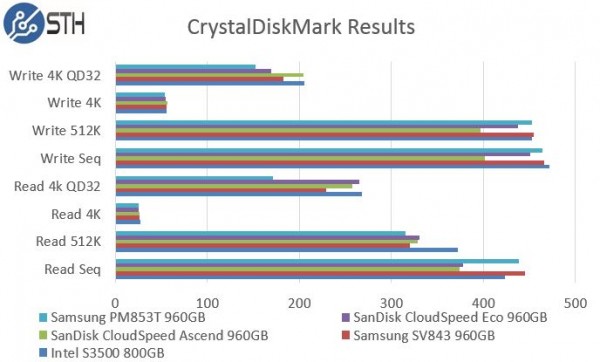
On CrystalDiskMark we can see that the QD32 read and write results are not the sweet spot for the PM853T. All other SSDs in the comparison group provide better performance. When it comes to sequential reads and writes, the Samsung PM853T 960GB fares better.
ATTO Benchmark
The value of the ATTO benchmark is really to show the best-case scenario. ATTO is known to write highly compressible data to drives, which inflates speeds of controllers that compress data like LSI/ SandForce does prior to writing on a given solid state drive.
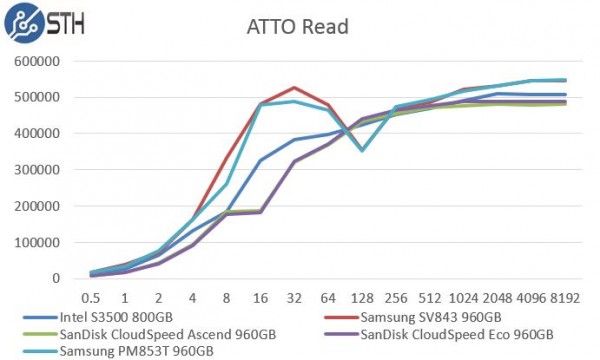
On the ATTO read benchmark side we see something extremely similar to what our Samsung SV843 960GB benchmark result showed which is a read hole around the 128k transfer size. One can see the performance is generally good, however there is a blip that we have seen on another Samsung drive.
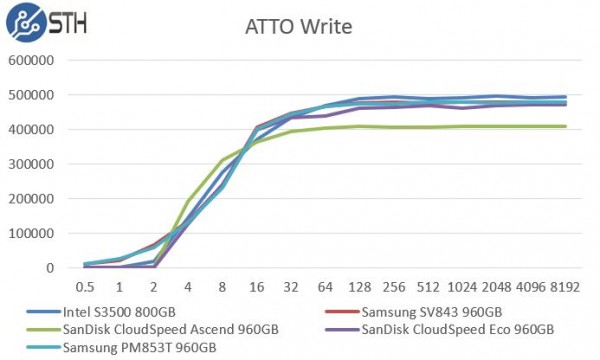
The write story does not show those same blips. Instead, we can see that the performance of the PM853T 960GB is much closer to what we would expect and outperforms the SanDisk CloudSpeed Ascend at small and large transfer sizes.
Closing Thoughts
Overall, we saw interesting results with this drive. The performance compared to peers was better than what we saw from the 480GB version of the drive. Samsung does an excellent job of maintaining performance for a read optimized drive. On the price side, these drives are great. These drives can be had for well under $0.8/GB in either the PM853T or 845DC EVO form. ebay pricing is already under $0.50/GB making this a fairly inexpensive way to get read optimized SSD capacity with PLP inexpensively.

